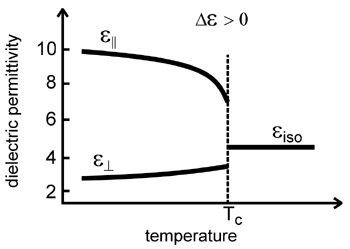4. Anisotropy in Liquid Crystals
Dielectric properties of LCs are related to the response of LC
molecules to the application of an electric field. Permittivity is a physical
quantity that describes how an electric field affects and is affected by a
dielectric medium and is determined by the ability of a material to polarize
in response to an applied electric field, and thereby to cancel, partially, the
field inside the material. In the LC materials consisting of non-polar molecules,
there is only an induced polarization, which consists of two parts: the electronic
polarization (which is also present at optical frequencies) and the ionic polarization.
In the LCs with polar molecules, there is in addition to the total induced polarization,
the orientation polarization, due to the tendency of the permanent dipole moments to
orient themselves parallel to the field.
Considering the uniaxial LC phases in a macroscopic coordinate
system x, y, z, with the z axis parallel to the director n, it is possible to
distinguish two principal permittivities, parallel to the director εII = εzz, and
perpendicular to the director
ε⊥ = 1/2(εxx + εyy).
Then the dielectric anisotropy
Δε = εII - ε⊥ can take positive and negative values. The graph of temperature
dependence of dielectric permittivities for a typical LC (Fig.8) shows that magnitude
of Δε usually depends on temperature, Δε∝S(T).

|
|
|
Figure 8. Temperature dependence of dielectric permittivity in liquid crystals with Δε > 0: Tc - clearing temperature; εiso - permittivity of isotropic liquid | |
For non-polar LCs the situation is relatively simple but in the case of polar molecules with permanent dipole moments, the orientation polarization must be added, which, by Maier and Meier, leads to an expression for the dielectric anisotropy

where Δα is a polarizability anizotropy, μ is a molecular dipole moment, F is parameter depending on the reaction field factor, kB is a Boltzmann constant and T is temperature. Then Δε is determined by the angle β between the molecule axis and the direction of the off-axis molecular dipole moment μ. The dipole contribution to Δε is positive for β < 54.7o and negative for β > 54.7o, which may result in negative Δε depending on the relative magnitude of two contributions. The larger the anisotropy the smaller electric field is needed to make the LC respond to it.
Prev
Optical anisotropy of LCs
Next
Main types of LCs